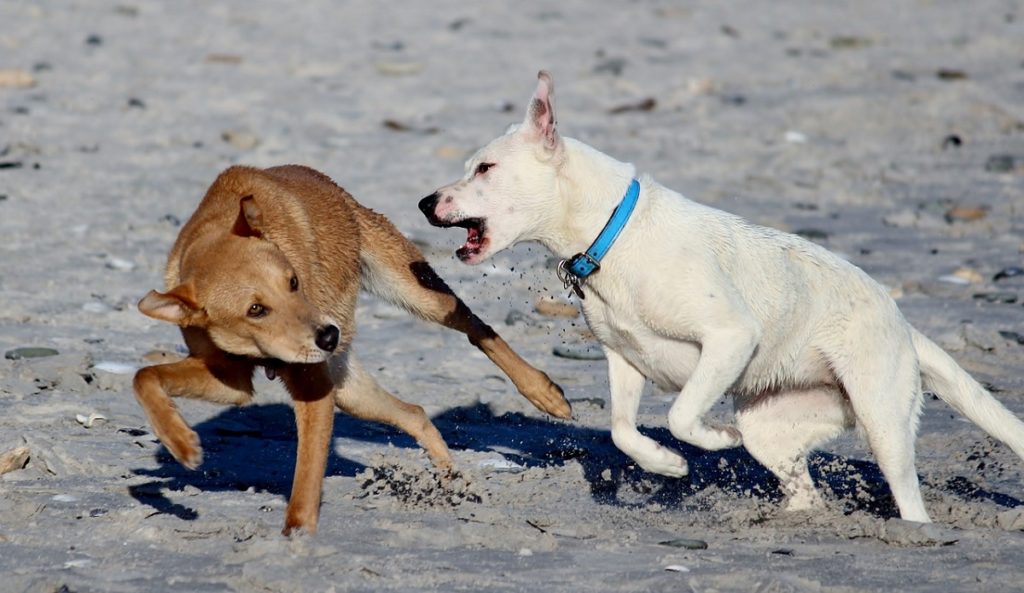You love your dog, so it may feel hard to witness or realize:
They can be a dominant aggressive dog.
And you’re not sure what to do about it.
It’s great that you are concerned and looking to take action; that is the first and one of the most important steps.
It happens to many dog owners, so you are not alone.
Read on to learn:
- Reasons your dog may be exhibiting this behavior
- The difference between dominant and aggressive dogs
- Ways to help if you have a dominant aggressive dog
What’s the Difference? Dominant vs. Aggressive
Dominant: When a dog wants to control the group and its decisions based on their belief of their place in a pack structure.
Aggressive: Describing behavior that a dog takes that go beyond dominance and involve threats and hostile actions, like snarling or biting.
Types of Dog Aggression
The 3 main types of dog aggression are:
- Dominance aggression*
- Fearful aggression
- Protective (territorial) aggression
*Dominance Aggression: This is the most common type of aggression. The main problem is rooted in the human not having control over the dog.
How Do You Know if Your Dog is Dominant Aggressive?
Especially if you’re a more novice dog owner, it’s easy to be confused on what is dominant or aggressive – and what is simply more normal, accepted dog behavior.
 Some traits that may dub your dog dominant:
Some traits that may dub your dog dominant:
- Refusal to obey commands or orders
- Unwillingness to be pushed from a sofa or bed
- Doesn’t like having their head reached over as if disrupting their hierarchy
- Being difficult to control, even if on a leash
- Any attempts to harm family or close loved ones they’ve met before and should know are okay
- Tends to bite
- Shows aggression toward other dogs and people
Okay so, if they are dominant, they may want to be the alpha.
The Hard-Wiring to Be Alpha
Alpha: The leader of a given pack.
They are the boss who wants to make all of the decisions.
Alphas typically know what they want and have the confidence to pursue it. This can lead to behavior that is dominant and/or aggressive.
This is not their fault; it’s hard-wired into their nature.
Dogs descend from animals that lived and had to survive in the wild, typically as part of a pack. The social system designation respect and obedience to one pack leader would decide everything from playtime to eating time.
The good news: Alpha is not necessarily based on size or strength; it’s the attitude of authority that sets the tone for mutual respect and willingness to follow.
Establish Yourself as the Alpha
If a dog feels they are the leader, they are going to assume it’s their right to do things their way and potentially be aggressive.
That is why you must be the alpha. To be the one they see as the leader who makes the decisions and that they must listen to.
To do that, you must:
- Show unwavering confidence that you are the leader; they respond to that with respect and allegiance.
- Consistent authority
Begin Dominant Dog Training Early
As with most things in life, the earlier the better.
Give Them Commands
Before interactions, command your dog to sit. This shows you are in control of their actions.
Use the Right Games as a Tool
A great way to set yourself up as alpha is to play the right games, such as fetch. You are in control of the ball. They have a good time playing along with you.
Try to stay away from aggressive games that involve their teeth and tugging!
Do NOT Physically Punish Your Dog
A dominant aggressive dog does not react well to physical punishment; in fact, it brings out their dominance.
What Works Better than Physical Punishment?
 Banishing them.
Banishing them.
Exiling your dog is highly effective because sent away, it shows they are not in control and cannot have an effect on the situation.
Send them to another room or put them in the backyard.
Show Your Control with Feeding
Feed them at specific times to make it clear that food does not simply appear; you control it.
This goes back to their descendants.
The pack leader is the one who makes decisions, like when to eat. They also are the one to eat first.
By showing you are the one to give the food and decide when they eat, you assert your dominance.
If you have a dominant dog, try following these helpful tips above. If the problem continues, consult with your veterinarian for further recommendations.




